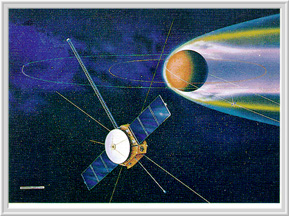An artist's conception of what the Planet-B spacecraft looks like while orbiting Mars.
Click on image for full size
Courtesy of NASA
Japanese Space Program Takes Off...
News story originally written on July 13, 1998
After a long, slow struggle, the Japanese space program is taking off! Japan's space program started as University researchers launching pencil-sized rockets in the 1950's. They struggled and fought against low budgets, some unsuccessful launches, and a bureaucratic split between the two Japanese space agencies, to finally build a rocket capable of putting probes into deep space. Just last week, Japan's struggle came to an end.
On July 4, 1998, the Planet-B probe was launched sucessfully by the Institute of Space and Astronautical Science (ISAS). Planet-B is on its way to Mars to study the upper Martian atmosphere and ionosphere, and its interaction with the solar wind. The probe carries 14 instruments from Japan, Canada, Sweden, Germany and the United States, but the spacecraft was built, launched and will be controlled solely by Japan. Barring any unforeseen mishaps, Planet-B will reach Mars in October making Japan the third country (along with Russia and the U.S.) to reach another planet.
This successful launch has paved the way for future Japanese missions. In the next years, they are hoping to send a mission to the Moon, to an asteroid, and to Mercury. Japan is the only Asian country participating in the International Space Station.
You might also be interested in:

It was another exciting and frustrating year for the space science program. It seemed that every step forward led to one backwards. Either way, NASA led the way to a great century of discovery. Unfortunately,
...more
The Space Shuttle Discovery lifted off from Kennedy Space Center at 2:19 p.m. EST, October 29th. The sky was clear and the weather was great as Discovery took 8 1/2 minutes to reach orbit for the Unitied
...more
A moon was discovered orbiting the asteroid, Eugenia. This is only the second time in history that a satellite has been seen circling an asteroid. A special mirror allowed scientists to find the moon
...more
Will Russia ever put the service module for the International Space Station in space? NASA officials are demanding an answer from the Russian government. The necessary service module is currently waiting
...more
During a period of about two days in early May, 1998, the ACE spacecraft was immersed in plasma associated with a coronal mass ejection (CME). The SWICS instrument on ACE, which determines unambiguously
...more
J.S. Maini of the Canadian Forest Service has referred to forests as the "heart and lungs of the world." Forests reduce soil erosion, maintain water quality, contribute to atmospheric humidity and cloud
...more
In late April through mid-May 2002, all five naked-eye planets are visible simultaneously in the night sky! This is includes Mercury which is generally very hard to see because of its proximity to the
...more















